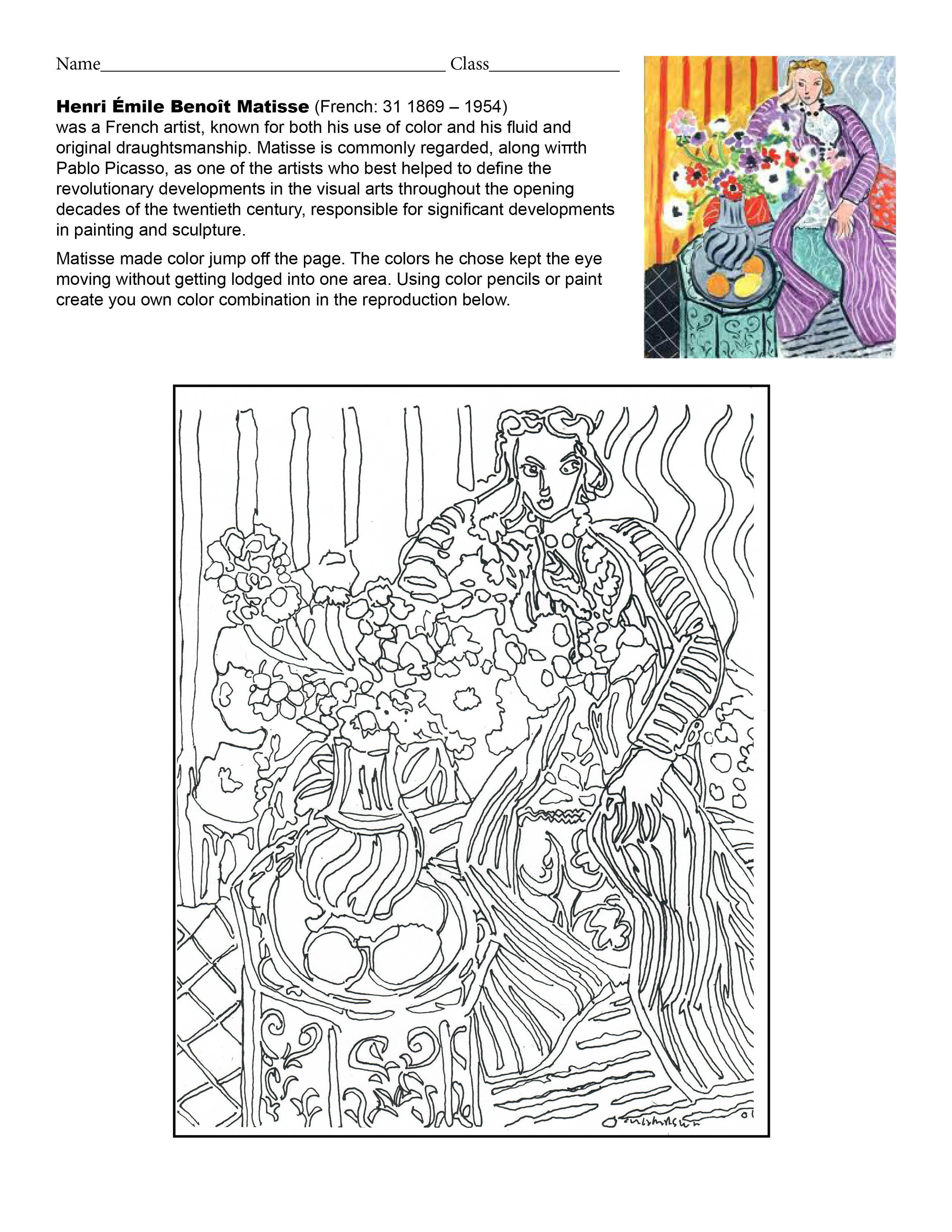Discovering the Artist
Henri Matisse
View the videos below, complete the reading and assessment form. Drag the Meet the Master sheet to your desktop and print it out then follow the directions. You have one week to complete this lesson.
In the last years of the life of Matisse he was taken care of by nuns who lived down the road from his house. As a thank you for helping him Matisse designed a Chapel for them. He designed it from outside in. The video below allows you to experience this chapel.
Henri Matisse
Henri Émile Benoît Matisse (French:1869 – 1954) was a French artist, known for both his use of colour and his fluid and original draughtsmanship. He was a draughtsman, printmaker, and sculptor, but is known primarily as a painter. Matisse is commonly regarded, along with Pablo Picasso, as one of the artists who best helped to define the revolutionary developments in the visual arts throughout the opening decades of the twentieth century, responsible for significant developments in painting and sculpture.
The intense colorism of the works he painted between 1900 and 1905 brought him notoriety as one of the Fauves (meaning wild beasts) an art movement that concentrates on color and decoration. Many of his finest works were created in the decade or so after 1906, when he developed a rigorous style that emphasized flattened forms and decorative pattern. In 1917 he relocated to a suburb of Nice on the French Riviera, and the more relaxed style of his work during the 1920s gained him critical acclaim as an upholder of the classical tradition in French painting. After 1930, he adopted a bolder simplification of form. When ill health in his final years prevented him from painting, he created an important body of work in the medium of cut paper collage.
Matisse creating with color and form as a child would.
His mastery of the expressive language of colour and drawing, displayed in a body of work spanning over a half-century, won him recognition as a leading figure in modern art.
Throughout his decades-long career as a painter, sculptor, draftsman, and printmaker, Henri Matisse continuously searched, in his own words, “for the same things, which I have perhaps realized by different means.” Celebrated as both an orchestrator of tonal harmonies and a draftsman capable of distilling a form to its essentials, he long sought a way to unite color and line in his work. The relationship between these two formal elements can be traced from early works like Dance (see below left)—in which the side of a dancer’s body, set against fields of rich blue and green, is described in a single, arcing contour—to his late cut-outs like The Swimming Pool (see below right), in which the artist discovered a way at the end of his life to “cut directly into vivid color.”
The Dance
The Swimming Pool
Matisse was born in 1869 to generations of weavers in Le Cateau-Cambrésis, a northern French town whose woolen mills constituted the main industry. He was raised in nearby Bohain, famous for its luxury fabrics. This early exposure to textiles would shape his visual language: examples from his own collection of carpets and cloths from Europe, Africa, and the Middle East would deeply inform his sense of color and pattern and appear in his compositions.
Taking up painting after first studying law, Matisse studied with the Symbolist Gustave Moreau and participated in Paris’s official Salons. His breakthrough as an artist came during the summers of 1904 and 1905, when the bright sunlight of the South of France inspired him—along with artists like André Derain and Maurice de Vlaminck—to create optically dynamic works of bright, clashing colors that led to these artists being derided with the epithet fauves (wild beasts). Known as Fauvism, the work from this period set him on a career-long path that he described as “construction by colored surfaces.” This approach remained central through the various stages of Matisse’s body of work—from his rigorous, abstracted paintings of the 1910s to the decorative, sunlit interiors of his so-called “Nice period” of the 1920s to the radically innovative cut-outs of his last decade.
Though much of his work—whether an ink drawing with a flowing arabesque line or a painting with flat expanses of unmodulated color—looks as if it might have been executed with effortless ease, Matisse cautioned that this effect was only an “apparent simplicity.” In reality, he labored exactingly to achieve the “art of balance, of purity and serenity” of which he dreamed.
Assignment:
Drag the following Meet the Masters sheet onto your desktop and print it out. Using color pencils, use you own colors to redefine this painting called Woman in the Purple Coat. Use vivid colors as Matisse did. When you are finished make a photo of your work and send it to ihs.db@yahoo.com.






